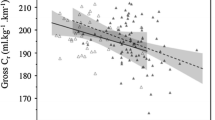Abstract
During high-intensity running, the oxygen uptake (V˙O2) kinetics is characterised by a slow component which delays the attainment of the steady-state beyond the 3rd min of exercise. To assess if the aerobic energy cost of running measured at the 3rd min (C 3) adequately reflects the variability of the true aerobic energy cost measured during the steady-state (C ss), 13 highly-trained runners completed sessions of square-wave running at intensities above 80% maximal oxygen uptake (V˙O2max) on a level treadmill. To evaluate the time at which the steady-state V˙O2 was attained (t ss), the V˙O2 responses were described using a general double-exponential equation and t ss was defined as the time at which V˙O2 was less than 1% below the asymptotic value given by the model. All the subjects achieved a steady state for intensities equal to or greater than 92% V˙O2max, and 8 out of 13 achieved it at 99% V˙O2max. In all cases, t ss was less than 13 min. For intensities greater than 85% V˙O2max, C ss was significantly higher than C 3 and was positively related to %V˙O2max (r= 0.44; P < 0.001) while C 3 remained constant. The C 3 only explained moderately the variability of C ss (0.39 < r 2 < 0.72, depending on the velocity or the (relative intensity at which the relationship was calculated). Moreover, the excess aerobic energy cost of running the (difference between C ss and C 3) was well predicted by age (0.90 < r 2 < 0.93). Therefore, when the aerobic profile of runners is evaluated, it is recommended that their running efficiencies at velocities which reflect their race intensities should be determined, with V˙O2 data being measured at the true steady-state.
Similar content being viewed by others
Author information
Authors and Affiliations
Additional information
Accepted: 1 June 1998
Rights and permissions
About this article
Cite this article
Bernard, O., Maddio, F., Ouattara, S. et al. Influence of the oxygen uptake slow component on the aerobic energy cost of high-intensity submaximal treadmill running in humans. Eur J Appl Physiol 78, 578–585 (1998). https://doi.org/10.1007/s004210050464
Issue Date:
DOI: https://doi.org/10.1007/s004210050464




